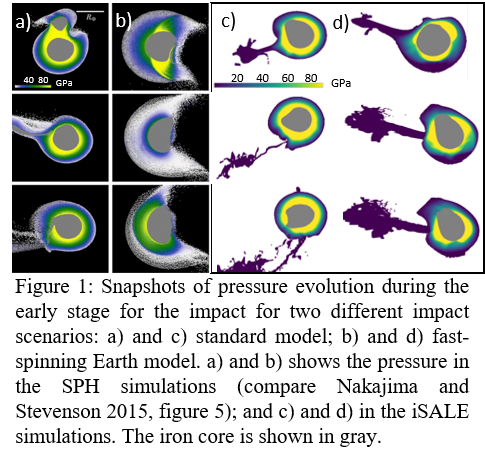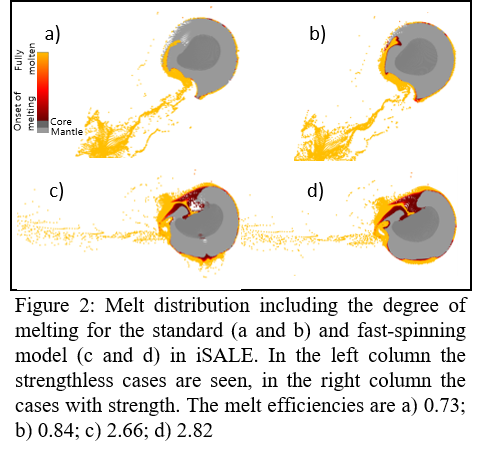Numerical modelling of the thermal state of Earth after the Moon-forming impact event - A benchmark study
- 1Museum für Naturkunde Berlin, Leibniz Institute for Evolution and Biodiversity Science, Germany
- 2Freie Universität Berlin, Institute for Geological Science, Germany
- 3Department of Earth and Environmental Sciences, University of Rochester, USA
Planetary collisions play an important role in the compositional and thermal evolution of the planetary system. The Moon-forming impact event is thought to be Earth’s last giant collision event, marking the end of the main accretion phase of the Earth. This large event (re)set the conditions for the subsequent thermochemical evolution of both bodies, Earth and Moon. Large parts of proto-Earth are thought to melt as a consequence of the impact and the extent of melting affects the evolution of the Earth’s interior and atmosphere. It is critical to address the initial conditions of the proto-Earth and the volume and shape of a possible magma ocean after the impact to understand the Earth’s subsequent evolution. To address these questions, we consider two different impact scenarios and present a benchmark study by comparing two different numerical codes. Further, we investigate the effect of strength on melt production for the two different impact scenarios. We compared results using the shock physics code iSALE [1,2], an Eulerian code with a fixed grid in space and a Langrangian mesh-free, so-called smoothed particle hydrodynamics code, (SPH [3]).
Therefore, we consider two different impact scenarios that are described in Nakajima and Stevenson (2015); the canonical model (i) (e.g., [4]) and a fast-spinning Earth model (ii) [5]. The former (i) assumes a Mars-size impactor colliding with proto-Earth at an impact angle of 41° (90° corresponds to head-on collision) at a velocity corresponding to the escape velocity of Earth. The colliding bodies are differentiated into a mantle and core. The latter (ii) case is characterized by a smaller impactor colliding with a rapidly rotating Earth at a steeper impact angle of 73° and a much higher impact velocity of 20 km/s. In iSALE the impactor and target mantle consist of dunite, the core of iron; both materials are represented by an Analytical Equation of state (ANEOS [6]), the SPH code uses an MgSiO3 liquid and ANEOS for forsterite and iron. In iSALE we neglect the core of the impactor as well as the initial spin of Earth. The pre-impact temperature of the colliding bodies is 2000 K and near the solidus. Nakajima and Stevenson (2015) only consider hydrodynamic behavior of the colliding bodies. In the iSALE models a constitutive model accounting for strength is included. Thus, in addition to a comparison of the two different codes, we investigate the effect of strength on melt production. The simulations of the two codes are compared in terms of thermodynamic parameters (pressure evolution, Figure 1) as well as melt production (Figure 2) after the moon-forming impact.
In Figure 1, a comparison of pressure evolution of both impact scenarios and the two numerical approaches is shown. In general, a good agreement in terms of pressure ranges for the two codes is observed. In the fast-spinning model a large fraction of mantle undergoes an extensive expansion and becomes subject to low pressure before some part falls back towards the core where it gains high pressures (Nakajima and Stevenson 2015). This process is not as prominent in the standard model. In the iSALE simulation we do not observe the fall back of the material although the post-impact state of Earth looks similar in both simulations.

The SPH simulations show that the majority of mantle experiences melting (between 80 and 100% mantle melting) pointing to the existence of a global magma ocean with a base close to the core-mantle boundary in both impact scenarios (Nakajima and Stevenson 2015).
The melt production obtained by the iSALE simulation is at least for the standard impact scenario smaller. For the fast-spinning Earth model about 60% of mantle material are molten. Thus, for the standard model, we only observe partial mantle melting whereas for the fast-spinning model we can assume that a global magma ocean exists. However, we have to note that the iSALE simulations have not run as long as the SPH simulations yet and that with a longer run time melt production most likely increases. Neglecting an impactor core in iSALE will also underestimate melt production. The accretion of the core would increase melting.
Regarding the effect of strength, we observe a slight increase of melting when the colliding bodies exhibit some initial strength. However, the effect of the chosen impact scenario is much more significant as seen in Figure 2. The melt efficiency (melt volume normalized by the impactor volume) is over three times larger for the fast-spinning Earth model (2.66 corresponding to 60% of mantle volume) than for the standard model (0.73 corresponding to 20 % of mantle volume).

The presented benchmark study shows an overall good agreement of two numerical codes and indicates the significance of the chosen impact scenario with respect to melt production on Earth during the Moon-forming impact. However, the differences of the two numerical methods may also be caused by some differences in the setup (e.g. different EoS, spin of Earth, differentiated impactor).
In addition, in an ongoing study we systematically carry out simulations of the moon-forming impact event using iSALE. We vary the impact angle (15° to 60°) and impact velocities (12 to 20 km/s) and use different initial temperature profiles. First results show that with increasing impact angle as well as with increasing impact velocity, melt production increases. The effect of the pre-impact temperature becomes more prominent for increased impact angles.
How to cite: Güldemeister, N., Manske, L., Nakajima, M., and Wünnemann, K.: Numerical modelling of the thermal state of Earth after the Moon-forming impact event - A benchmark study, Europlanet Science Congress 2020, online, 21 September–9 Oct 2020, EPSC2020-217, https://doi.org/10.5194/epsc2020-217, 2020

